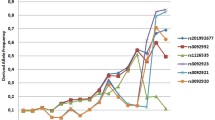Abstract
The Duffy (FY) blood group system is clinically significant in transfusion medicine because FY antibodies are involved in hemolytic transfusion reactions and hemolytic disease of the newborn. The Fya and Fyb antigens are encoded by the FY*A and FY*B alleles which are responsible for the Fy(a+b+), Fy(a+b−) and Fy(a−b+) phenotypes. The Fy(a−b−) phenotype is found in individuals homozygous for a silent FY*B allele, named FY*B ES, which is caused by a mutation in the promoter region of FY*B that result in the loss of FY expression in the erythroid linage. The aim of the present study was to evaluate the role of FY DNA typing as a tool in transfusion compatibility testing. We studied 275 white blood donors from the city of Rosario by serological method and allele specific PCRs. We found that the 106 serologically Fy(a+b+) samples all genotyped as FY*A/FY*B (100%). Among the 94 Fy(a+b−) samples, 81 (86.2%) were FY*A/FY*A and 13 (13.8%) were FY*A/FY*B ES . Of the 75 Fy(a−b+) 67 (89.3%) were FY*B/FY*B and 8 (10.7%) were FY*B/FY*B ES. No Fy(a−b−) samples were encountered. The frequencies of the FY*A, FY*B and FY*B ES alleles clearly revealed that the genetic pool analyzed is comprised of Caucasian and non-Caucasian alleles. These results showed that there is an important proportion of patients phenotyped as Fy(b−) that can be exposed to Fy(b+) blood units with no risk of alloimmunization when they carry the FY*A/FY*B ES genotype. Thus, FY genotyping allow increasing the pool of compatible units facilitating transfusion therapy and benefiting patients that require chronic transfusions.
Similar content being viewed by others
References
Daniels G (2002) Human blood groups. Blackwell, Oxford
Westhoff CM (2006) Molecular testing for transfusion medicine. Curr Opin Hematol 13:471–475
Cutbush M, Mollison PI, Parkin DM (1950) A new human blood group. Nature 165:188–189
Issitt PD, Anstee DJ (1998) Applied blood group serology, 4th edn. Montgomery Scientific Publications, Durham
Yazdanbakhsh K, Rios M, Storry JR, Kosower N, Parasol N, Chaudhuri A, Reid ME (2000) Molecular mechanisms that lead to reduced expression of Duffy antigens. Transfusion 40:310–320
Klein HG, Anstee DJ (2005) Blood transfusion in clinical medicine, 11th edn. Blackwell, Oxford
Castilho L, Rios M, Bianco C, Pellegrino J, Alberto F, Saad S, Costa F (2002) DNA-based typing of blood groups for the management of multiply-transfused sickle cell disease patients. Transfusion 42:232–238
Sakhalkar VS, Roberts K, Hawthorne LM, McCaskill DM, Veillon DM, Caldito GC, Cotelingam JD (2005) Allosensitation in patients receiving multiple blood transfusions. Ann N Y Acad Sci 1054:495–499
Schonewille H, van de Watering L, Brand A (2006) Additional red blood cell alloantibodies after blood transfusions in a nonhematologic alloimmunized patient cohort: is it time to take precautionary measures? Transfusion 46:630–635
Cotorruelo C, Fiori S, García Borrás S, Racca L, Biondi C, Racca A (2008) Distribution of the FYB ES and RHCE*ce(733C > G) alleles in an Argentinean population: implications for transfusion medicine. BMC Med Genet 9:40–48
Martinez Marignac VL, Bertoni B, Parra EJ, Bianchi NO (2004) Characterization of admixture in an urban sample from Buenos Aires, Argentina, using uniparentally and biparentally inherited genetic markers. Hum Biol 76:543–557
Conflict of interest statement
The authors declare that they have no conflict of interest related to the publication of this manuscript.
Author information
Authors and Affiliations
Corresponding author
Rights and permissions
About this article
Cite this article
Cotorruelo, C., Biondi, C., Racca, L. et al. Duffy genotyping facilitates transfusion therapy. Clin Exp Med 9, 249–251 (2009). https://doi.org/10.1007/s10238-009-0032-6
Received:
Accepted:
Published:
Issue Date:
DOI: https://doi.org/10.1007/s10238-009-0032-6




